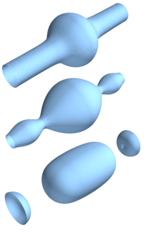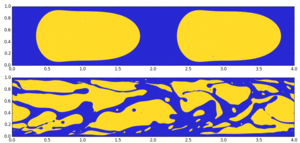Within this area of study, models are developed and new proposal for turbulent flows with the dispersed phase (droplets, solid particles).
Closures for ensemble-averaged or spatially-filtered transport equations for turbulent flows, including two-phase flows, are analysed, new proposals are put forward and validated. The interest is focused on statistical approach with the use of probability density function (PDF) methods, modelling turbulent dispersion of particles in the Reynolds-averaged (RANS) description, as well as the residual (sub-grid scale) dispersion while the larger-scale structures of turbulent flow are resolved (LES, POD).
Practical importance of these studies relates to problems of chemical and process engineering, as well as conventional and distributed power production (eg. liquid fuel and coal powder industrial burners).

Particle-laden turbulent flow: coaxial confined jet,
snapshot, LES results (Łuniewski, 2011).
An alternative approach to flow modelling is the use of a fully Lagrangian formalism, for example the Smoothed Particle Hydrodynamics (SPH).The SPH method is increasingly often used for analysis of multiphase flows, flows with free surface, or systems with complex or variable geometry. One of the advantages of SPH is no need of numerical grid. Continuous distributions of physical quantities are replaced by the corresponding integral approximations. The fluid is treated as a finite set of particles (representing fluid elements), for which calculations are made. On the drawback side of the approach, being intensely worked on nowadays, are adaptivity in terms if spatially-variable resolution, and usually longer computation times w.r.t. the traditional, grid-based approaches.
The SPH approach is increasingly often used for analysis of multiphase and free-surface flows, and systems of complex or variable geometry. Through advection of particle sets corresponding to separate phases, SPH naturally describes the evolution of interphasial surfaces (see Figure). There also exist SPH formulations for dispersed flows, based on two-fluid models. We have used and further developed them for the modelling of sediment transport in water.
a) 
b) 
Smoothed Particle Hydrodynamics computations of interfacial flows. (a) The Rayleigh-Plateau instability: 3D breakup of a liquid filament (Olejnik & Szewc, JTAM 2018). (b) Flow regimes in 2D chanel flow: slug (upper) and churn (lower); Olejnik et al., ICMF 2016.
Research focuses on modelling of flow and heat transfer in porous media. The practical motivation is to improve the coking process of coal.
For the purpose, the Lattice Boltzmann Method (LBM) is used to simulate the phenomena of fluid flow, heat transfer, plastic deformation and chemical reactions on a mesoscale level of a few grains. The LBM is promising for the simulations of viscous fluid flow and heat transfer in media with complex geometry.
Recently published work shows that LBM can also be used in a various and interesting engineering applications (internal combustion, flow of blood red cells, etc.). At present, the fluid flow and heat transfer are analysed in a granular medium with grains of temperature-affected geometry. Research is underway to add stresses at the contact surface of grains (structure-structure interactions) and to model chemical reactions with additional source terms.

Flow through simple model of porous media, LBM computation (Grucelski, 2012).